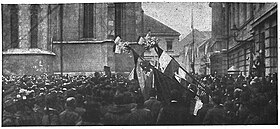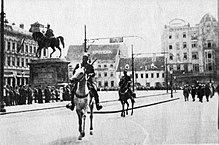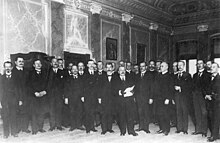State of Slovenes, Croats and Serbs
State of Slovenes, Croats and Serbs | |||||||||||||||||
|---|---|---|---|---|---|---|---|---|---|---|---|---|---|---|---|---|---|
| 1918 | |||||||||||||||||
Kingdom of Serbs, Croats and Slovenes with Austria. | |||||||||||||||||
| Status | Unrecognised provisional government seeking unification with Serbia | ||||||||||||||||
| Capital | Zagreb | ||||||||||||||||
| Common languages | |||||||||||||||||
| President of National Council | |||||||||||||||||
• 1918 | Anton Korošec | ||||||||||||||||
| Vice President | |||||||||||||||||
• 1918 | Ante Pavelić Sr. | ||||||||||||||||
• 1918 | Svetozar Pribićević | ||||||||||||||||
| Legislature | National Council of Slovenes, Croats and Serbs | ||||||||||||||||
| Historical era | Interwar period
Kingdom of Serbs, Croats and Slovenes | 1 December 1918 | |||||||||||||||
| Population | |||||||||||||||||
• Estimate | 6,000,000 | ||||||||||||||||
| |||||||||||||||||
The State of Slovenes, Croats and Serbs (
Name
The state's name derives from the three main
.The Croats identified in the name were those residing in the preceding kingdoms of
The Serbs identified in the name were those residing in
The Slovenes identified in the name were the residents of the Duchy of Carniola, Duchy of Styria, Duchy of Carinthia and Prekmurje.
Creation
Background
In 1918, the final year of the War, the Austro-Hungarian monarchy was suffering from an internal crisis accompanied by unrest amongst the multiple Slavic peoples within its borders.
- Cisleithania: The Austrian Littoral, Duchy of Carniola and the Kingdom of Dalmatia were under Austrian jurisdiction. The neighbouring duchies of Styria and the Carinthia also included a significant South Slavic population.
- Međimurje, Baranja and territories that had been part of the Voivodeship of Serbia and Banat of Temeschwar.
- The Austro-Hungarian Condominium of Bosnia and Herzegovina.
Activities of the pro-Yugoslav forces in the Transleithanian Kingdom of Croatia-Slavonia on 30 May 1917 resulted in adoption of the May Declaration by the Yugoslav Club, a group of Croatian and Slovene deputies in the Reichsrat (the legislature of Cisleithania in Vienna). The Declaration sought the unification of all the lands in the Habsburg monarchy populated by Slovenes, Croats, and Serbs in one independent entity.[5]
On 2–3 March 1918,
In July and August 1918, the so-called "People's organizations of Slovenes, Croats and Serbs" were formed in
On 14 September 1918, Austro-Hungarian Foreign Minister Stephan Burián von Rajecz issued a statement advocating a settlement of World War I by peace treaty and it became apparent that the war was coming to an end. By early October, the Slovene-Croat-Serb movement were planning to set up a National Assembly. Svetozar Pribićević, the leader of the Croat-Serb Coalition, confronted Srđan Budisavljević, one of the leaders of this movement, in an effort to determine whether these plans were meant to undermine the Coalition, and the two reached an understanding whereby the Coalition would be invited to join any future National Council before a National Assembly was formed. At the same time, the organizers obtained support from the Croatian People's Peasant Party and the Serb People's Radical Party. On 5 and 6 October, a provisional assembly was convened and the formation of executive committees begun. Seats were apportioned to members of all parties,[7] but not without acrimony over the ad hoc nature of the proceedings.[10]
Establishment


The People's Council (
The
On 14 October 1918, Austrian foreign minister Burián asked for an armistice based on the
On 21 and 22 October, members of the
Numerous mass rallies were held in Zagreb in support the Yugoslav cause, especially on 22 October.

On 28 October, Gyula Andrássy the Younger sent a peace note to the American government while the Ban of Croatia, Antun Mihalović, reported to the Emperor and was dismissed with the instruction "Do as you please".[13] The Ministry of War had also decided to allow the local military commands to approach the people's councils in order to help maintain law and order. All this was taken as a sign that the Austro-Hungarian monarchy was disintegrating and that the State of Slovenes, Croats and Serbs was an attainable goal.[14]
The state was proclaimed officially on 29 October 1918. Its first president was a Slovene,
The new state aspired to include all those territories of the former
Conflict with Italy
In order to avoid handing them to the Entente Powers, Emperor Karl assigned the entire Austro-Hungarian Navy, the Austro-Hungarian merchant fleet and all Austro-Hungarian harbours, arsenals and shore fortifications to the National Council. The National Council sent diplomatic notes to the Entente governments notifying them that they had taken control of these assets and were not at war. The fleet, however, was soon attacked and dismembered by the Italian navy, the Regia Marina.
Austria-Hungary reached an armistice with Italy through the
Creation of the Kingdom of Serbs, Croats, and Slovenes


The State of Slovenes, Croats and Serbs did not obtain international diplomatic recognition before it ceased to exist. In a note of 31 October, the National Council informed the governments of the United Kingdom, France, Italy and the United States that the State of Slovenes, Croats and Serbs was constituted in the South-Slavic areas that had been part of Austria-Hungary, and that the new state intended to form a common state with Serbia and Montenegro. The same note was sent to the government of the Kingdom of Serbia and the Yugoslav Committee in London. Serbia's prime minister Nikola Pašić responded to the note on 8 November, recognizing the National Council in Zagreb as "legal government of Serbs, Croats and Slovenes living in the territory of the Austria-Hungary", and notified the governments of the United Kingdom, France, Italy and the United States asking them to do the same.
On 23–24 November, the National Council declared "unification of the State of Slovenes, Croats and Serbs formed on the entire, contiguous South-Slavic area of the former Austria-Hungary with the Kingdom of Serbia and Montenegro into a unified State of Slovenes, Croats and Serbs". 28 members of the council were appointed to implement that decision based on National Council's adopted directions on implementation of the agreement of organization of the unified state with the government of the Kingdom of Serbia and representatives of political parties in Serbia and Montenegro. The instructions were largely ignored by the delegation members who negotiated with Regent Alexander instead.[6]
Stjepan Radić's Peasant Party participated in the National Council, but after it decided to merge with Serbia, they started to back off, calling the move foolish, and disputing the decision based on the fact that the Croatian Parliament never explicitly approved it.[15]
On 1 December, Regent Alexander proclaimed unification of "Serbia with lands of the independent State of Slovenes, Croats and Serbs into a unified
The National Council's final important task was to appoint representatives to the Temporary National Representation in early 1919.[16]
See also
- Geneva Declaration (1918)
- Lipošćak affair
- Podgorica Assembly
- History of Yugoslavia
- Verigar issue
- Slovene March
- Timeline of Croatian history
References
- ^ Mitrović, Andrej (2007). "Serbia's Great War, 1914–1918". London: Hurst & Company. Archived from the original (PDF) on 3 March 2012. Retrieved 15 November 2010.
- ^ a b (in Serbian) Vladimir Ćorović, Ilustrovana istorija Srba (knjiga šesta), Belgrade, 2006.
- ^ a b (in Serbian) Drago Njegovan, Prisajedinjenje Vojvodine Srbiji, Novi Sad, 2004.
- ^ Matijević 2008, p. 36.
- ^ "Svibanjska deklaracija | Hrvatska enciklopedija". enciklopedija.hr.
- ^ a b c d e f Boban 1993
- ^ a b Štambuk-Škalić & Matijević 2008
- ^ Matijević 2008, p. 43.
- ^ Matijević 2008, pp. 44–45.
- ^ Matijević 2008, p. 45-48.
- ^ Matijević 2008, p. 61.
- ^ Matijević 2008, p. 48.
- ^ Matijević 2008, p. 50.
- ^ Matijević 2008, pp. 50–51.
- ^ "Povijest HSS-a" (PDF) (in Croatian). Croatian Peasant Party. p. 10. Archived from the original (PDF) on 7 April 2013.
24. studenog – Govor Stjepana Radića na sjednici središnjeg odbora Narodnog vijeća SHS – Gospodo! Još nije prekasno! Ne srljajte kao guske u maglu. 1. prosinca 1918. Adresa delegacije Narodnog vijeća SHS regentu Aleksandru i proglašenje nove države Kraljevstva Srba, Hrvata i Slovenaca. Ulazak Hrvatske u ovu državnu tvorevinu Hrvatski sabor nije odobrio ni potvrdio, na što je opetovano ukazivao Stjepan Radić, osporavajući na taj način njezin legitimitet. 31. prosinca u DOM-u objavljen članak S. Radića Republika ili slobodna narodna država konstituanta ili narodni revolucionarni sabor.
- ^ Matijević 2008, p. 66.
Sources
- Matijević, Zlatko (November 2008). "Narodno vijeće Slovenaca, Hrvata i Srba u Zagrebu: Osnutak, djelovanje i nestanak (1918/1919)" (PDF). Fontes (in Croatian). 14 (14). ISSN 1330-6804.
- Štambuk-Škalić, Marina; Matijević, Zlatko, eds. (November 2008). "Narodno vijeće Slovenaca, Hrvata i Srba u Zagrebu 1918–1919. Izabrani dokumenti". Fontes (in Croatian). 14 (1). Croatian State Archives: 71–596. Retrieved 8 December 2010.
- ISSN 0353-295X. Retrieved 16 December 2012.
External links
- Država Slovenaca, Hrvata i Srba (1918) (in Croatian)
- Map Archived 5 December 2012 at archive.today


